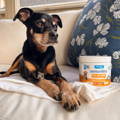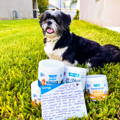Can You Use Neosporin On Dogs? Benefits, Risks, & More
Vet Verified
WRITTEN BY DR. RHAYSA FELICIANO
Jump to Section

Have you ever eyed your family tube of Neosporin® for something other than human use? Can you use Neosporin on dogs’ wounds? Neosporin is known to be a topical antibiotic for minor skin infections and minor cuts for humans, but is Neosporin safe for dogs?
This ointment, armed with antimicrobial prowess, can help shield against infections. Can it do the same for our four-legged friends? Join us on a journey through the unexplored realms of canine care to learn how Neosporin can help with doggy well-being.
What is Neosporin®?
Neosporin is the brand name for an over-the-counter triple topical antibiotic ointment designed for human use, with a petrolatum base. Petrolatum is alternatively known as petroleum jelly, soft paraffin, or white petrolatum. The three antibiotic ingredients in Neosporin are bacitracin zinc, neomycin sulfate, and polymyxin B. These active ingredients provide effectiveness against a wide range of bacteria. Certain variations of the product may also include a local analgesic (pain reliever) called pramoxine.
Neosporin is typically used to treat minor skin infections and cuts and aid in wound healing by repairing the physical barrier of the skin. Although Neosporin is designed for human use, many dog owners wonder if it is safe for dogs. Before using Neosporin on your pet, you should learn about its safety for canines and the potential impacts on your dog's health.
Can you use Neosporin on dogs?
Can you put Neosporin on a dog? Yes, you can use Neosporin on dogs but only in some circumstances. This over-the-counter ointment, packed with neomycin, polymyxin B, and bacitracin, can be great in a pinch but it’s important to understand when you should put it on your dog and when you shouldn’t.
So can you use Neosporin on dogs? Yes, you can. While you can put Neosporin on a dog for minor first aid uses, frequent application may hinder natural wound healing. Excessive use could lead to sensitivities or resistance, so consult your vet before adopting Neosporin for dogs as part of your pet’s care routine. Whether you’re seeking pain relief, need to gently cleanse your dog's wounds, or want to remove bacteria, you should understand the best treatment options available for your dog.
Vet Tip
For most minor abrasions, you don’t need to apply anything to the skin. Small wounds and scrapes can heal well on their own if kept clean.
Is Neosporin safe for dogs?
Yes, Neosporin is safe for dogs as long as it is used sparingly and correctly. Using it as an antibiotic ointment for dogs in minor first aid applications is fine, however, moderation is key. Excessive application might lead to adverse reactions, so consult your veterinarian to make sure that it aligns with your furry companion's unique health profile.
When using Neosporin on your dog, it’s important to watch for any signs that they might not be handling it well. These signs include redness, rash, or swelling where you’ve applied the cream. If you see any of these, you should contact your vet right away. Also, remember that Neosporin is not for deep or serious wounds––those are best treated by a veterinary professional. Never let your dog lick the area where it’s applied, as this could lead to an upset stomach; keeping the ointment out of reach is best practice for this same reason.
Can Neosporin be used on dogs' wounds?
Can you use Neosporin on dogs' wounds? Yes, but only for minor wounds like scrapes and small cuts. Its neomycin, polymyxin B, and bacitracin composition help prevent infections. But, it's not a cure-all; large and severe wounds or those needing stitches require veterinary attention. Using Neosporin for dogs can help create a protective barrier on top of the wound to aid in healing, and prevent additional bacteria from entering an open wound. Always consult your veterinarian for tailored advice on your pet's wound care!

Keith Homan / Shutterstock.com
How should I apply Neosporin to my dog?
When it comes to Neosporin on dogs, application can be tricky. You can repeat as directed, but always consult your vet for tailored guidance on your canine companion's wound care.
Speak with your vet first
Call or email your vet clinic to make sure the type of wound you’re treating is suitable for an antibiotic ointment like Neosporin, or if you should skip it and seek immediate medical attention.
keep your pet comfortable
If your pet has a minor scratch or abrasion, use tools like distraction to keep them comfortable. That could mean giving them a treat or employing a friend to pet them while you tend to the wound.
cleanse the wound
Gently cleanse the wound with warm water to remove any visible debris. Pat the area dry with a clean cotton pad or towel.
apply avoiding sensitive areas
Apply a thin layer of Neosporin to the wound, making sure to avoid sensitive areas like the eyes, nose, and mouth.
AVOID LETTING YOUR DOG LICK NEOSPORIN
Antibiotic ointments like Neosporin aren’t safe for your pet to ingest, so do what you can to keep their attention away from the area as it heals.
Potential benefits of Neosporin for dogs
Using Neosporin on dogs can be beneficial as needed for quick wound care. The medicated ingredients in the formula form a barrier against potential infections.
The blend of neomycin, polymyxin B, and bacitracin can create a preventive shield of sorts, helping to prevent bacterial infiltration that could otherwise lead to infections. This combination is a particularly valuable tool for pet owners navigating the realm of minor injuries.
Potential risks of using Neosporin on your dog
While using Neosporin for dogs aids minor wounds, be cautious. Neomycin, found in Neosporin, is an antibiotic that is known to cause hypersensitivity or allergies in some individuals, including pets. When applied topically, common side effects can include redness, irritation, and itching at the application site. It's important to be aware of potential adverse reactions and consult with a veterinarian if you observe any concerning symptoms in your pet after using a product containing Neomycin.
Neosporin can cause issues if ingested by dogs
If dogs ingest Neosporin, ingredients like neomycin in the formula can cause health issues. Ingestion can lead to stomach problems, vomiting, or diarrhea. Additionally, the antibacterial properties that benefit external wounds might disrupt the natural balance of the digestive system when internally consumed, underscoring the importance of preventing dogs from licking or ingesting Neosporin.
If your dog has consumed the ointment, refrain from inducing vomiting unless explicitly instructed to do so by your veterinarian. Petroleum-based substances pose an elevated risk of entering the respiratory system and potentially causing aspiration pneumonia.
Alternatives to using Neosporin on dogs
When it comes to addressing wounds in your canine companion, there are options beyond using Neosporin on dogs. Consider these antibiotic ointment alternatives:
Bactroban (Mupirocin): Renowned for combating bacterial infections and particularly effective for skin issues related to Staph infections.
Vetericyn Plus: A cutting-edge solution with advanced hypochlorous (disinfecting) technology that’s used to cleanse and heal minor wounds.
Silver Sulfadiazine Cream: Known for its broad-spectrum antibacterial properties, it's particularly effective for burn wounds.
Mueller-Hinton Agar: Often utilized in veterinary settings, it's a reliable medium for antibiotic susceptibility testing (a diagnostic test for finding out which antibiotic treatment will be effective in treating fungal or bacterial infections).
These alternatives extend beyond Neosporin's conventional benefits to offer multiple applications for canine care. Always consult with your veterinarian to determine the most suitable option based on the nature and severity of your dog's wound––whether it be a minor wound that you can treat with Neosporin, or something more serious.
The best way to treat a dog’s minor wounds at home
Treating minor wounds on your dog at home can be straightforward if you follow some basic steps. Begin by calmly cleaning the wound with mild soap and lukewarm water to remove any dirt or debris. Gently pat the area dry with a clean cloth, taking care not to irritate the wound further.
Next, apply a small amount of a pet-safe antibiotic ointment, such as Neosporin, unless your vet advises otherwise. This helps prevent infection and keeps the area clean. Cover the wound with a sterile bandage to protect it, especially if your dog tends to lick or scratch at injuries. Make sure the bandage isn’t too tight to ensure comfortable healing.
It’s important to monitor the wound for signs of infection like increased redness, swelling, or pus. Change the bandage daily and check the wound each time for any changes. If the wound doesn’t improve within a few days, shows signs of infection, or if your dog seems uncomfortable, it's best to consult your vet for further guidance.
Join the Pack!

Sign up for exclusive deals, curated pet tips from veterinarians, and product launches!
Pet Parents are Also Reading
June, 2023
October, 2022
July, 2023
August, 2023
Written by a Vetnique Vet
Dr. Rhaysa Feliciano, DVM
Veterinarian Dr. Rhaysa Feliciano of Winter Garden, FL has always had a passion for helping animals. She’s been a “HUGE" fan of Glandex for years and recommends it to all of her patients with anal sac disease, and is passionate about helping pets with allergies find a better quality of life.
Veterinarian
Winter Garden, FL
Sign up for exclusive deals, curated pet tips from veterinarians, and product launches!






















